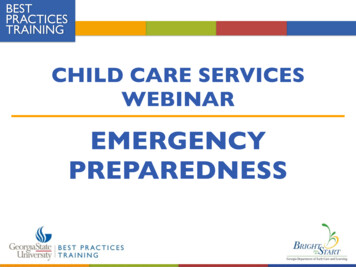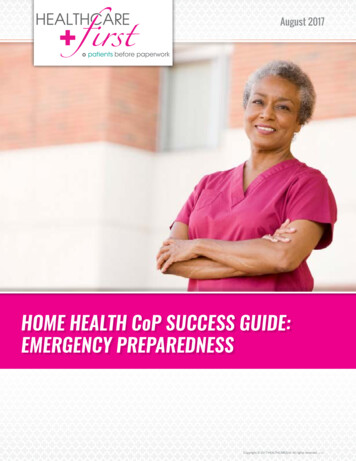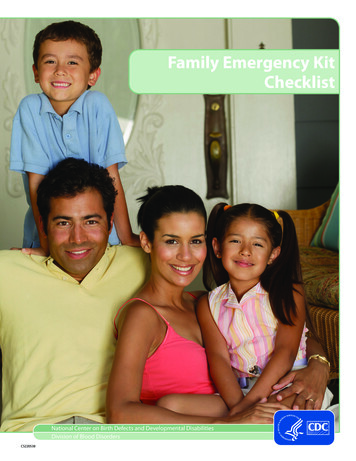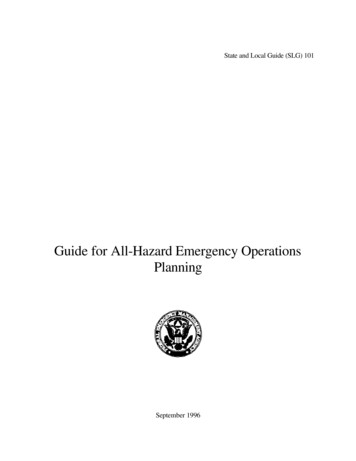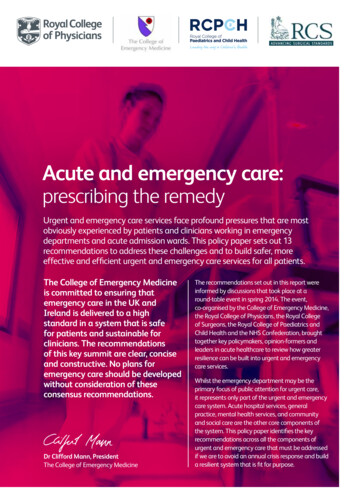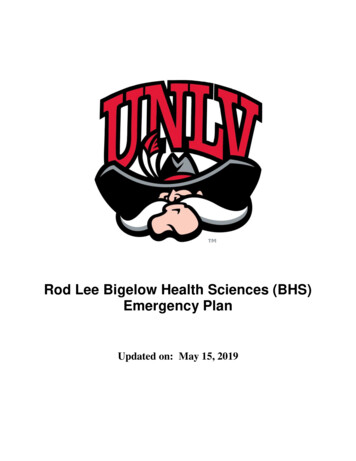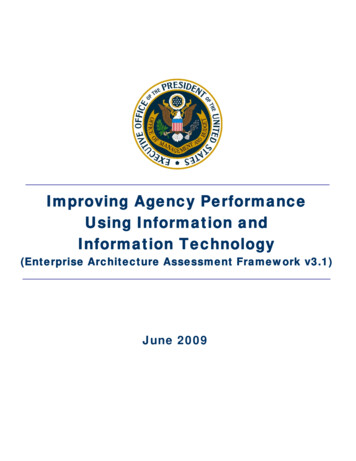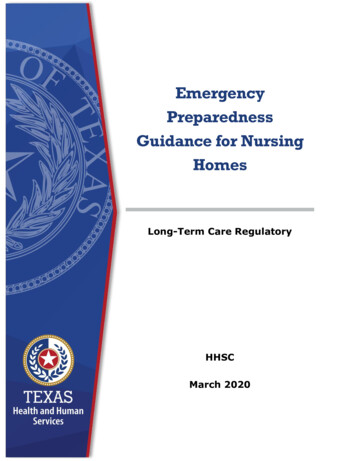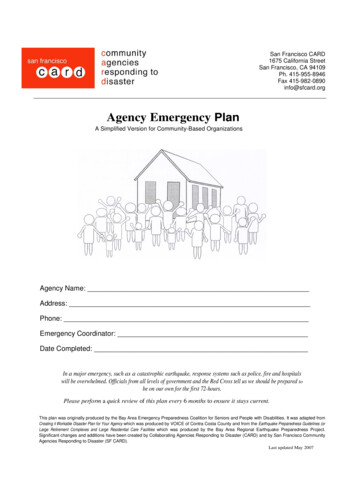
Transcription
San Francisco CARD1675 California StreetSan Francisco, CA 94109Ph. 415-955-8946Fax 415-982-0890info@sfcard.orgAgency Emergency PlanA Simplified Version for Community-Based OrganizationsAgency Name:Address:Phone:Emergency Coordinator:Date Completed:In a major emergency, such as a catastrophic earthquake, response systems such as police, fire and hospitalswill be overwhelmed. Officials from all levels of government and the Red Cross tell us we should be prepared tobe on our own for the first 72-hours.Please perform a quick review of this plan every 6 months to ensure it stays current.This plan was originally produced by the Bay Area Emergency Preparedness Coalition for Seniors and People with Disabilities. It was adapted fromCreating A Workable Disaster Plan for Your Agency which was produced by VOICE of Contra Costa County and from the Earthquake Preparedness Guidelines (orLarge Retirement Complexes and Large Residential Care Facilities which was produced by the Bay Area Regional Earthquake Preparedness Project.Significant changes and additions have been created by Collaborating Agencies Responding to Disaster (CARD) and by San Francisco CommunityAgencies Responding to Disaster (SF CARD).Last updated May 2007
AGENCY EMERGENCY PLANA. Disaster Mission StatementMake sure you know what role you are planning to play in a disaster Who are you going to be for your clients and communitywhen disaster strikes? Does your current mission statement encompass how yousee your agency functioning in a disaster? Think about your commitments and your resourcelimitations and create a disaster mission statement.B. Preparing Staff for EmergenciesMake sure your staff is mentally, physically and emotionally prepared to respondIn an emergency, the first concern of staff will be the safety and welfare of family members.1.Have all staff and key volunteers trained in basic emergency preparedness on a regular basis.2.Encourage and support staff and key volunteers to have a family or home emergency plan (see note below).This increases the likelihood that staff and their families can cope with the disaster without outside help.3.Your agency will want to ensure that all staff members have an opportunity to check on their homes and familymembers as soon as possible following a disaster.Note: SF CARD offers an interactive personal preparedness class, and organizations like the American Red Crossoffer other helpful trainings such as First Aid and CPR.Links: One-Page Personal Preparedness sheet; Disaster Preparedness for PetsAEP - Simplified for Community-Based OrganizationsPage 2 of 15Last updated May 2007
AGENCY EMERGENCY PLANC. PersonnelMake sure you have enough people to meet the response needs of the organizationDetermine your staffing requirements for post-disaster response.I. Realistically, how many staff will continue working after a disaster if it strikes during work?2. If a disaster strikes on a weekday, but before the workday begins?3. If a disaster strikes on a weekend?4. Which staff should automatically report to work in the event of a disaster?5. Develop a list of home telephone numbers for staff for emergency use. (Update at least every 6-months.)6. To support the work staff in an emergency, we will use volunteers as follows:a.b.c.d.e.D. VolunteersMake sure you know the best ways to use and work with volunteers in a disasterKnow how you will appropriately recruit, task and manage volunteers.1.Are your current volunteers appropriate for disaster related work?2.Do your current practices of recruiting or accepting volunteers include your disaster preparedness and response needs?3.What important activities (that keep your agency able to provide services) can be assigned to spontaneous volunteers? Whatactivities should not be assigned to spontaneous volunteers4.What safety and/or legal considerations should you include in your plan? Consider: do you have proper insurance for volunteers, do youneed background checks on volunteers, is any specialized training or knowledge required for working with your agency or clients, etc.?5.Do you have someone in charge of volunteers? Who (else) might take that role for new volunteers?AEP - Simplified for Community-Based OrganizationsPage 3 of 15Last updated May 2007
AGENCY EMERGENCY PLANE. Meeting the Needs of the People You ServeMake sure you can address the basic needs of staff, volunteers and clientsI.How many total clients would most likely be at your site in a disaster? (Look at both maximum client load and minimum staffavailability for day, for evening and for weekends.)2. How will you find out about the condition of people you serve who are off site?3.In an emergency, who else needs information about the status of people you serve? Off site staff? Families of clients? List the mostcritical contacts that need to be made. Be sure to have all necessary phone, cellular phone and pager numbers for each contact.4. What else will be needed (e.g., bedding, medicine, special equipment, etc.)? Where can you get these ion:5. What are the special needs of the people you serve? Are these needs of the group or of individuals?Also consider: What skills can you instill in your clients to let them take part in your preparednessand response efforts as full partners and helpers?AEP - Simplified for Community-Based OrganizationsPage 4 of 15Last updated May 2007
AGENCY EMERGENCY PLANF. On-Site Supplies CacheMake sure you have preparedness supplies availableCreate and maintain an onsite cache of emergency preparedness supplies. The exact contents will depend on the size and diversity of yourstaff, volunteers, clients and potential visitors. Remember to consider special needs additions such as medication.Store these supplies in multiple locations so if one cache becomes unusable or unreachable, you will still have options. The supply cachecomplements your agency go-kit.Some basic contents of an on-site supply cache are:oooFood and WaterFirst Aid tlesoooBlanketsGarbage BagsDuct TapePerishable supplies, such as food, water and medicine, need to be replaced regularly. One way to do this is by "cycling" the food and water- eat supplies while they are still good, and put new ones in the cache.G. Agency Go-KitMake sure you can operate even if you evacuateIf you need to evacuate your facility, an Agency Go-Kit will allow you to continue providing your most vital services whereveryou go. This small, portable container should hold copies of every vital document as well as some basic supplies such as penand paper.Some basic contents of an Agency Go-Kit are: Your disaster planInsurance documentationThe deed or lease for your facilitiesLegal identification, such as your taxpayer ID number and evidence of exemption statusBank information, including all of your account numbers, including personnel contactsDocumentation for your emergency line of creditMemoranda of Understanding (MOUs)Contact and Emergency Contact information for your staff and key contactsSome cash, including coins for phonesYou may wish to maintain more than one kit. Creating two is no harder than creating one, and an off-site backup may be what ensuresthat you have needed records.AEP - Simplified for Community-Based OrganizationsPage 5 of 15Last updated May 2007
AGENCY EMERGENCY PLANH. Facility PreparationMake sure your physical environment supports your safetyASSIGNED TODATE DONE Bolt heavy cabinets, bookshelves or other furniture to wall studs Strap computers, fax, equipment to desk or tables Secure pictures and other wall hangings by using safety hooks Clear exits, pathways and earthquake-safe spaces Fasten breakables to walls or shelves with museum wax Lower heavy items to bottom shelves Remove fire and chemical hazards Install smoke detectors, fire extinguishers, cabinet latches Label fire exits and safety supplies Clearly mark your gas and water shut-off valves. Post clearsimple instructions for shutting off each one (in alllanguages needed).Keep a conveniently located set of tools to facilitate promptgas shut-off. Tools should include both pipe and crescentwrenches. Earthquake Putty (also called Museum Wax) holds delicate items in placeStraps brace heavy furniture and large items in placeSafety hooks stop pictures, clocks and mirrors from fallingCabinet latches help keep glass and dishware from falling to the floorSketch your facility and note vital emergency resources including:Fire extinguishersGo kitsTool kitsSupply CacheAEP - Simplified for Community-Based OrganizationsFirst Aid SuppliesWater shutoffGas shutoffEscape routesGenerator(s)Documents safePage 6 of 15Last updated May 2007
AGENCY EMERGENCY PLANI. SignageMake sure your safety and preparedness tools are well-markedMake preparedness visible! Clear and visible signs indicating safety tools, exits and emergency instructions will help peopleto keep themselves safe while at your agency.Tool Box: Lives HereWATER SHUT-OFFTAEP - Simplified for Community-Based OrganizationsPage 7 of 15Last updated May 2007
AGENCY EMERGENCY PLANJ. Neighborhood ResourcesMake sure you know the local resources – they may be your only sourceI.If you do not have a back-up generator, in an extended power outage, where can you rent or borrow a generator?Create a written agreement with a supplier.2. If the phones at your agency are not working, where are the nearest pay phones?3. Where is the nearest public health clinic?Clinic Name:Address:Phone:4. Where is the nearest Neighborhood Disaster Community Hub (for San Francisco)?Place Name:Address:Phone:5. Where is the nearest fire station (or NERT / CERT staging area) and do they know about your agency?Station Name:Address:Phone:6. Where is the nearest police station and do they know about your agency?Station Name:Address:Phone:Make sure preparedness resources in your neighborhood are clear. Post a large, clear map of yourneighborhood. Note these potentially valuable resources, and highlight:Key Resource FrameworkoooooooCity HallHuman Services, Dept. of PublicHealth & other gov’t agenciesFire stationPolice stationRed CrossPublic libraryLiaison connectionso SF CARDo Volunteer Centero Partner agenciesoMedicalo Hospitalo Community Clinicso Veterinaryo PharmaciesoAEP - Simplified for Community-Based OrganizationsPossible gathering pointso Church, mosque, synagogueo Schoolo Gymo Shelterso Open SpaceoFood / Watero Food Banko Salvation Armyo Soup kitchenso Grocery storeso RestaurantsoSupplieso Hardware storeso Disaster storeso Drug storeso Sports /Camping storeso “Big-box” storeso Dollar storesoPage 8 of 15Last updated May 2007
Agency Emergency PlanK. Evacuation / TransportationMake sure you can get people from your location to a safe alternate siteFire, hazardous material spills or structural damage may require you to evacuate your building.I.Are there program participants who will need assistance evacuating your facility?Remember to assign staff and volunteers to help these participants and have assistive aids/devices available to help with theirevacuation.2.If your facility must be evacuated, assign a staff person the responsibility of taking a head count to ensure all staff, volunteers andprogram participants have exited.3. Practice your evacuation plan.4.Keep an "Agency Go-Kit". Include copies of your emergency plan, action checklists, phone rosters, copies of vital documents,credit cards, etc.5. Post a notice indicating where you have gone.The following suggestions anticipate that you must evacuate your building and that you are responsible for the careand shelter of the people you serve.6.Locate and secure a temporary shelter to be used (consider churches, nearby community centers, schools, other residentialfacilities). You may want to develop mutual aid agreements with these sites.Temporary Shelter Name:Address:Contact Name:Phone:7.Create a phone list and a system for letting the authorities, family and friends know where you are sheltering your programparticipants. "Date created" should appear on this and all lists and documents.8.Designate and identify alternative transportation for moving your program participants to your temporary shelter, or to clients'homes, if necessary.Alternative Transportation:Contact Name:Phone:9. Assign responsibility for the care of your clients at the alternate site(s). Identify this person or persons.a.b.10. If evacuated, what will your clients need that may not be available in the temporary shelter?a.b.AEP - Simplified for Community-Based OrganizationsPage 9 of 15Last updated May 2007
AGENCY EMERGENCY PLANL.L.CommunicationI) 1)Communication(Part(PartMake sureyou can communicate with staff, clients, funders and your communityMake sure you can communicate with staff, clients, funders and your communityCommunications will make or break a disaster response. From a simple note on the door identifying your newlocation to a Public Information Officer correcting news reports about your agency, communication is the key toletting people make the right decisions.WHAT should you communicate?ooooooAgency Operational Status reportsDamage assessmentServices offered or changedFunds neededVolunteers neededOther needsooTO WHOM are you communicating?o Disaster services partnerso Staff & Volunteerso Clientso Funderso Mediao General publicooWHO should communicate the message?ooooPeople with proper trainingThose with the proper authorityPeople who share a consistent messageHOW should you communicate?o Electronico Papero Verbalo CombinationoWHAT can you prepare in advance?oooooAgency talking points / key messageDisaster / emergency response press releaseEmergency related funding solicitationE-mail, phone, text, cell-phone, fax listsAEP - Simplified for Community-Based OrganizationsPage 10 of 15Last updated May 2007
AGENCY EMERGENCY PLANL. Communication (Part 2)Make sure you know all the communication tools available to youMastering how you send and receive information will help you in both crisis and opportunity. A variety of options isthe key to maintaining communications.Disaster Communication ToolsThere are many communication tools we don't normally consider that may become useful if a disaster cuts off yournormal channels.oBulletin / White boardsoMegaphones / BullhornsoCarbon / NCR paperoPagers / texting devicesoCB radiosoStandard telephonesoCell phonesoPublic signageoDigital phones / BlackberriesoRunnersoDrumsoWalkie – talkiesoFlag polesoWhistlesoHam RadiosoooCommunity Outreach OptionsWhat are all the different ways you can speak to your community? Different methods have different advantages, andmay help you reach people you had not reached before.oAmerican sign language (ASL)oIn-person events, workshops or classesoComputers – DSL, Cable, dial-upoLanguage translatorsoDoor-to-door canvassingoMailing lists: brochures, flyersoE-mail / list-servesoRadio, televisionoFact sheets – FAQsoVideo, cassette tape, CD / DVDoFax machines / Win faxoWebsitesoInformation lines – 2-1-1oooAEP - Simplified for Community-Based OrganizationsPage 11 of 15Last updated May 2007
AGENCY EMERGENCY PLANM.I) 1)M.ICSICS(Part(PartMakeMakesuresureyouyou knowknow seResponse systemSystemThe state of California uses the Standardized Emergency Management System (SEMS) to respond to disasters. Understanding theIncident Command System that is the core of SEMS will allow you to organize for managing any situation, coordinate with yourcommunity partners, and "speak the language" of the professional responders - which makes you much more valuable to your community.Incident Commander1.2. (Alt)Public Information OfficerSafety & Security Officer1.1.2 Alt.2 Alt.OperationsPlanningLogisticsTeam ChiefTeam ChiefTeam ChiefFinance / AdministrationTeam Chief1.1.1.1.2 Alt.2 Alt.2 Alt.2 Alt.Incident Command: (In charge) Leads the response; appoints and empowers team leaders – ICS allows for scaled effortsto meet the demands of an incident. It is flexible and adaptable; some incidents may not require the use of Planning, Logisticsor Finance, while others will require all of them. ICS allows for filling only the parts of the organizational structure that areneeded. Expanding the network is key to an effective response as more people are added to the response.FEMA ICS training is available online.SF CARD teaches simplified ICS for nonprofits at your siteSafety and Security Officer: Focuses on the safety of all people responding to the incident.Public Information Officer: Works with the media and distributes messages to the public and local community.Operations Team: (Does things) Handles key actions including first aid, search and rescue, fire suppression and securingthe site.Planning Team: (Plans things) Gathers information, thinks ahead and keeps all team members informed andcommunicating.Logistics Team: (Gets things) Finds, distributes, and stores all necessary resources (supplies and people) to respondappropriately.Finance / Administration Team: (Records things) Tracks all expenses, claims and activities and is the record keeperfor the incident.AEP - Simplified for Community-Based OrganizationsPage 12 of 15Last updated May 2007
AGENCY EMERGENCY nia’sUniversalResponseSystemConsidering who might do well at certain functions is an excellent tool for understanding SEMS and getting people used to the idea. Becareful, though: you never know who will be part of your disaster response team, so be prepared to assign roles when they are needed.Primary FunctionsIncident CommanderName:Name:Phone:Phone:Alt. Ph:Alt. Ph:Operations Team ChiefName:Name:Phone:Phone:Alt. Ph:Alt. Ph:Planning Team ChiefName:Name:Phone:Phone:Alt. Ph:Alt. Ph:Logistics Team ChiefName:Name:Phone:Phone:Alt. Ph:Alt. Ph:Finance / Administration Team ChiefName:Name:Phone:Phone:Alt. Ph:Alt. Ph:Support FunctionsSafety and Security OfficerName:Name:Phone:Phone:Alt. Ph:Alt. Ph:Public Information OfficerName:Name:Phone:Phone:Alt. Ph:Alt. Ph:AEP - Simplified for Community-Based OrganizationsPage 13 of 15Last updated May 2007
AGENCY EMERGENCY PLANN. Financial ResourcesMake sure you know your financial assets, limitations and commitmentsIt is a good idea for your organization to be aware of its cost of normal operations; estimate cost increases that mightarise from emergencies and be familiar with eligibility and other prerequisites for aid and reimbursements from FederalEmergency Management Agency (FEMA) and other agencies.Some topics to explore include the following:1. Copies of Financial Support Documentation to have readyoInsurance policiesoThe deed or lease for your facilitiesoBank information, including all of your account numbers, including personnel contactsoLegal identification, such as your taxpayer ID number and evidence of exemption statusoMemoranda of Understanding (MOUs)2. Liquid AssetsoHow much cash do you keep in "petty cash?"oDo you have 15 - 20 in coins for pay phones?3. Credit Cards / Lines of CreditoWhat credit cards does your agency own?oWhere are they?oWhat are the limits of each?oWho can sign on each?oDo they have emergency credit extensions?oDo you have a line of credit immediately available?oWho can access the money?Reminder: Keep this information updated;be sure it reflects any staff or policy changes!AEP - Simplified for Community-Based OrganizationsPage 14 of 15Last updated May 2007
AGENCY EMERGENCY PLANO. Ensuring Service ContinuationMake sure your service priorities are clearWhat is needed to continue providing essential services after a disaster?I. List the primary services you will continue to provide following an emergency?a.b.c.2. What are the critical material resources necessary to maintain these operations?a.b.c.3.What neighboring agencies or businesses can you form a connection with in order to share resources in an emergency, tomaintain operations and to ensure the care of people you Your organization should clarify what its mission and priorities will be in the aftermath of a major disaster. It isimportant for agencies working with at-risk clients on a daily basis to know their client's needs and how to supporttheir recovery following a disaster.4. Some questions to ask include: What are the predictable needs of the people you serve in emergencies? Will the needs of the people you serve require you to expand services in a disaster's aftermath? Will you need to consider providing new or different services?Remember: Knowing your priorities as an agency makes everything else fall intoplace. In crisis or opportunity, if you are clear on your priorities you can makethe best decisions for your agency.AEP - Simplified for Community-Based OrganizationsPage 15 of 15Last updated May 2007
San Francisco CARD is a member of the PrepareNow Partners, a collaboration of agencies throughout the Bay Area thatprovides disaster training and resources to nonprofits and congregations of all faiths.San Francisco City and CountyNapa CountySF CARD1675 California StreetSan Francisco, CA 94109Phone: 415-955-8946Fax: 415-982-0890www.sfcard.orginfo@sfcard.orgThe Volunteer Center of Napa Valley1820 Jefferson StreetNapa, CA 94559Phone: 707-252-6222 x and / Alameda CountySan Mateo CountyCARD – Collaborating Agencies Responding to Disaster1736 Franklin Street, Ste. 450Oakland, CA 94612Phone: 510-451-3140Fax: orgThrive – The Alliance of Nonprofits for San Mateo CountyMail: P.O. Box 132, San Carlos, CA 94070Office: 703 Woodside Road #7Redwood City, CA 94061Phone: 650-766-1162Fax: nce.orgMarin CountySanta Clara CountyCenter for Volunteer and Nonprofit LeadershipAmeriCorps / Vista Program555 Northgate DriveSan Rafael, CA 94903Phone: 415-479-5710http://cvnl.org/community/disaster prep.htmlinfo@cvnl.orgCADRE – Collaborating Agencies Disaster Relief EffortVolunteer Center of Silicon Valley1922 The Alameda, Ste. 100San Jose, CA 95126Phone / fax sv.us
Note : SF CARD offers an interactive personal preparedness class, and organizations like the American Red Cross offer other helpful trainings such as First Aid and CPR. Links: One-Page Personal Preparedness sheet; Disaster Preparedness for Pets AEP - Simplified for Com munity -Based Organizations Page 2 of 15 Last updated May 2007

